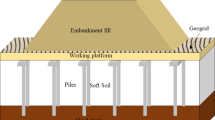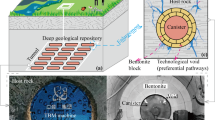Abstract
Pre-compacted MX80 bentonite/Callovo-Oxfordian (COx) claystone mixture has been proposed to backfill and seal the underground galleries for radioactive waste disposal in France. While emplacing these pre-compacted blocks, technological voids are created between the blocks and the host rock and among the blocks themselves. It is expected that homogenization process will take place over time for the structure constructed with pre-compacted blocks upon hydration. This study investigated the boundary friction effect on such a process. Results showed that after the filling of technological voids, the soil far from the technological voids would swell further, while those near the voids would be compressed under the welling pressure generated by the soil behind, resulting in an increase in homogeneity in terms of dry density distribution. However, this homogenization process would stop after a certain time. Further examination showed that the homogenization process ended when the maximum boundary friction force became equal to or higher than the vector sum of swelling forces in the radial direction. Based on the force equilibrium and the mass conservation, the final dry density distribution was estimated. Comparison between the estimation and the measurement showed a good agreement, indicating the relevance of the identified mechanism related to boundary friction.








Similar content being viewed by others

Abbreviations
- a 1, b 1, a 2, b 2 :
-
Fitting parameters for swelling pressures
- a 3, b 3 :
-
Parameters reflecting dry density distribution
- ρ d :
-
Dry density
- ρ d-overall :
-
Overall dry density
- T :
-
Thickness of samples
- R :
-
Thickness of samples
- r :
-
Radius of element
- \(\theta\) :
-
Angle of element
- dr, d \(\theta\) :
-
Radius and angle increments
- P a :
-
Axial swelling pressure
- P r :
-
Swelling pressure in the r direction
- \(P_{\theta }\) :
-
Swelling pressure in the \(\theta\) direction
- S f :
-
Friction stress
- \(S_{\text{f}}^{l}\) :
-
Limiting friction stress
- F s :
-
Vector sum of swelling forces in the radius direction
- F f :
-
Friction force of two sides
- ϕ :
-
Friction angle
- c :
-
Cohesion
References
Bian X, Cui YJ, Li XZ (2018) Voids effect on the swelling behaviour of compacted bentonite. Géotechnique 69(7):593–605
Delage P, Le TT, Tang AM, Cui YJ, Li XL (2008) Suction effects in deep Boom clay block samples. Géotechnique 57(2):239–244
Fouché O, Wright H, Le Cléac’h JM, Pellenard P (2004) Fabric control on strain and rupture of heterogeneous shale samples by using a non-conventional mechanical test. Appl Clay Sci 26(1–4):367–387
Gens A, Vállejan B, Sánchez M, Imbert C, Villar MV, Van Geetl M (2011) Hydromechanical behaviour of a heterogeneous compacted soil: experimental observations and modelling. Géotechnique 61(5):367–386
Gens A, Pomaro B, Sánchez M, Villar MV (2018) On the hydration of unsaturated barriers for high-level nuclear waste disposal. In: Unsaturated soils: UNSAT 2018—the 7th international conference on unsaturated soils, pp 55–60
Jia LY, Chen YG, Ye WM, Cui YJ (2019) Effects of a simulated gap on anisotropic swelling pressure of compacted GMZ bentonite. Eng Geol 248:155–163
Komine H, Ogata N (1994) Experimental study on swelling characteristics of compacted bentonite. Can Geotech J 31(4):478–490
Komine H, Ogata N (1999) Experimental study on swelling characteristics of sand-bentonite mixture for nuclear waste disposal. Soils Found 39(2):83–97
Potyondy JG (1961) Skin friction between various soils and construction materials. Géotechnique 11(4):339–353
Pusch R (1982) Mineral–water interactions and their influence on the physical behavior of highly compacted Na bentonite. Can Geotech J 19(3):381–387
Saba S (2013) Hydro-mechanical behaviour of bentonite-sand mixture used as sealing materials in radioactive waste disposal galleries (Doctoral dissertation, Université Paris-Est)
Sellin P, Leupin OX (2013) The use of clay as an engineered barrier in radioactive-waste management: a review. Clays Clay Miner 61(6):477–498
Villar MV, Lloret A (2007) Dismantling of the first section of the FEBEX in situ test: THM laboratory tests on the bentonite blocks retrieved. Phys Chem.Earth Parts A/B/C 32(8–14):716–729
Villar MV, Lloret A (2008) Influence of dry density and water content on the swelling of a compacted bentonite. Appl Clay Sci 39(1–2):38–49
Villar MV, Iglesias RJ, García-Siñeriz JL, Lloret A, Huertas F (2019) Physical evolution of a bentonite buffer during 18 years of heating and hydration. Eng Geol. https://doi.org/10.1016/j.enggeo.2019.105408
Wang Q, Tang AM, Cui YJ, Delage P, Barnichon JD, Ye WM (2013) The effects of technological voids on the hydro-mechanical behaviour of compacted bentonite–sand mixture. Soils Found 53(2):232–245
Yong RN, Boonsinsuk P, Wong G (1986) Formulation of backfill material for a nuclear fuel waste disposal vault. Can Geotech J 23(2):216–228
Zeng ZX, Cui YJ, Zhang F, Conil N, Talandier J (2019) Investigation of swelling pressure of bentonite/claystone mixture in the full range of bentonite fraction. Appl Clay Sci. https://doi.org/10.1016/j.clay.2019.105137
Zhong WZ, Rusinek A, Jankowiak T, Abed F, Bernier R, Sutter G (2015) Influence of interfacial friction and specimen configuration in Split Hopkinson Pressure Bar system. Tribol Int 90:1–14
Acknowledgements
The authors are grateful to Ecole des Ponts ParisTech, the China Scholarship Council (CSC) (Grant No. 201708440292) and the French National Agency for Nuclear Waste Management (ANDRA) for their financial supports.
Author information
Authors and Affiliations
Corresponding author
Additional information
Publisher's Note
Springer Nature remains neutral with regard to jurisdictional claims in published maps and institutional affiliations.
Rights and permissions
About this article
Cite this article
Zeng, Z., Cui, YJ., Conil, N. et al. Analysis of boundary friction effect on the homogenization process of compacted bentonite/claystone mixture with technological voids upon hydration. Acta Geotech. 16, 525–533 (2021). https://doi.org/10.1007/s11440-020-01048-x
Received:
Accepted:
Published:
Issue Date:
DOI: https://doi.org/10.1007/s11440-020-01048-x



